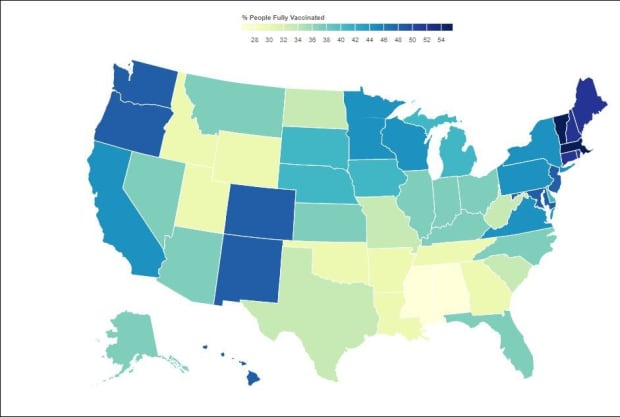This post was originally published on this site
The Delta variant of COVID-19 has now been detected in 74 countries, prompting fears it will become the dominant strain around the world, as it continues to spread rapidly including in Southern U.S. states that have lagged on vaccination.
The highly infectious variant that was first detected in India has been found in countries including China, the U.S. and the U.K., according to the World Health Organization, where it accounted for more than 90% of new cases in the past week. That prompted Prime Minister Boris Johnson to delay the U.K.’s planned reopening for another four weeks in an announcement at a news briefing on Monday.
In the U.S., cases are roughly doubling every two weeks, according to former Food and Drug Administration Commissioner Scott Gottlieb and now account for at least 10% of new cases, he told CBS’ “Face the Nation” on Sunday.
“That doesn’t mean that we’re going to see a sharp uptick in infections, but it does mean that this is going to take over,” said Gottlieb. “And I think the risk is really to the fall that this could spike a new epidemic heading into the fall.”
Concerns about the Delta variant come as California lifts most of its COVID-19 restrictions and ushers in what it is calling the Golden State’s “Grand Reopening,” as the Associated Press reported.
Starting Tuesday, there will be no more state rules on social distancing, and no more limits on capacity at restaurants, bars, supermarkets, gyms, stadiums or anywhere else. And masks — one of the most symbolic and fraught symbols of the pandemic — will no longer be mandated for vaccinated people in most settings, though businesses and counties can still require them.
The U.S. has now fully vaccinated almost 145 million people, or 43.7% of its overall population, according to a tracker created by the Centers for Disease Control and Prevention. That means those people have received two shots of the two-dose vaccines developed by Pfizer Inc.
PFE,
and German partner BioNTech SE
BNTX,
and Moderna Inc.
MRNA,
or one shot of the Johnson & Johnson
JNJ,
single-shot vaccine. The AstraZeneca
AZN,
AZN,
vaccine has not been authorized for use in the U.S.
Among Americans 18 years and older, 54.4% are fully vaccinated and 64.5% have received at least one dose. Among those 65 years-and -older, about 42 million people are fully vaccinated, equal to 76% of that group. More than 47 million people in that age bracket have received a first jab, covering 86.8% of that population.
But as the map below illustrates, vaccination rates vary widely from state to state, and Southern states, including Louisiana, Alabama and Mississippi showing the lowest rates.
Only Maine, Vermont, Massachusetts, Connecticut and Rhode Island have managed to fully inoculate more than 50% of their populations so far.

Source: Johns Hopkins University
Elsewhere, France is opening its vaccination drive to those over 12 years old. In Russia, some regions are again tightening restrictions and Ireland is doubling the quarantine period for unvaccinated or partially vaccinated travelers from mainland Britain to 10 days, according to transport minister Eamon Ryan.
There was disappointing news for AstraZeneca, which said a Phase 3 trial to assess the safety and efficacy of a long-acting antibody combination, called AZD7442, for the prevention of symptomatic COVID-19 after exposure didn’t meet the primary goal, as the Wall Street Journal reported.
However, the drug reduced the risk of developing symptomatic Covid-19 by 73% in participants who tested negative in a polymerase chain reaction, or PCR, test at time of dosing, AstraZeneca said. In patients who were PCR negative, AZD7442 reduced the risk of developing symptomatic Covid-19 by 92% compared to a placebo more than seven days after dosing, and by 51% up to seven days after dosing, the company said.
Novavax
NVAX,
said a study evaluating co-vaccination against COVID-19 and the flu demonstrated similar efficacy to administering Novavax’s experimental COVID-19 shot alone. “Separate healthcare visits to cover both COVID-19 and influenza vaccinations will be burdensome,” a Novavax executive said in a news release.
The news comes a day after Novavax said its coronavirus vaccine had an efficacy rate of 90.4% when it comes to preventing symptomatic infection in roughly 30,000 participants enrolled in the Phase 3 clinical trial in the U.S.
See now: Disney World and Disneyland won’t require fully vaccinated visitors to wear masks anymore
Latest tallies
The global tally of confirmed cases of COVID-19 climbed above 176.2 million on Tuesday, according to data aggregated by Johns Hopkins University, while deaths climbed above 3.8 million.
The U.S. continues to lead the world in total cases at 33.47 million, while deaths total 599,963.
India is second in total cases at 29.6 million and third by fatalities at 377,031, although those numbers are expected to be undercounted given a shortage of tests.
Brazil has the third-highest caseload at 17.5 million, according to JHU data, and is second in deaths at 488,288.
Mexico has fourth-highest death toll at 230,187 and 2.5 million cases.
The U.K. has 128,171 fatalities and 4.6 million cases, the highest number of deaths in Europe and fifth-highest in the world.
China, where the virus was first discovered late in 2019, has had 103,403 confirmed cases and 4,846 deaths, according to its official numbers, which are widely held to be massively underreported.

